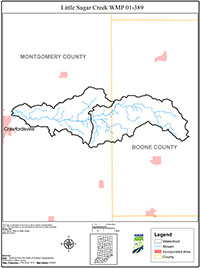Summary
The Little Sugar Creek Watershed is located approximately 40 miles Northwest of Indianapolis. This watershed is part of the larger Sugar Creek watershed. The Little Sugar Creek 11-digit watershed contains two 14-digit subwatersheds. The watershed consists of 29,074 acres and is contained in both Boone and Montgomery Counties. Little Sugar Creek is listed on Indiana’s 303(d) List of Impaired Waterbodies for Mercury, PCB’s, and Fish Consumption Advisory.
The Little Sugar Creek Watershed contains mostly agricultural land-uses with a small amount of residential and business. Not much development is occurring within the watershed. However, agriculture land-uses, predominantly corn and soybean production, continue to dominate the land. The watershed also contains areas of livestock production, which is the second largest land use practice and has been a concern for citizens in the area.
The Little Sugar Creek Watershed: Looking Toward Future Horizons document is the result of 22 months of conducting research, gathering information, holding public meetings, education, and initiating discussions among watershed residents, local and government agencies, business owners, agricultural producers, and interested citizens to identify watershed concerns and address them. A Steering Committee was formed to lead discussion of concerns. The committee developed the following mission statement that explains the purpose of this project: To identify problems in the Little Sugar Creek watershed and educate landowners of why good water quality is important and how they can affect it.
This Watershed Management Plan was created as a result of the committee’s efforts to reduce pollution as much as possible from nonpoint sources in the watershed. In order to accomplish this, the Committee focused its attention on four main areas in the watershed:
- Agricultural nonpoint source pollution from cropland activities
- Agricultural nonpoint source pollution from livestock farming
- Lack of vegetated riparian buffers near Little Sugar Creek and its tributaries
- Education for landowners in the watershed and community members on nonpoint source pollution problems and solutions
The Steering Committee developed goals and objectives to address each of the four topics. Cropland Agriculture Goals that included reducing manure application of fertilizer by educating about soil testing and optimum usage for certain soil types, seeing no-till on 50% of corn after soybeans and 90% of beans after corn, and increasing awareness on how cropping practices can impact water quality and about cost-share available through other programs such as the Farm Bill. Livestock Agriculture Goals focused on promoting use of alternative water and manure management systems in the Little Creek Sub-watershed and fencing livestock from waterways, where applicable. Riparian Goals include installing buffer strips in the Little Creek sub-watershed, connecting buffers along waterways to create corridor in Needam-Booher sub-watershed, and educating the public on the importance of habitat. And Educational Goals that start Hoosier Riverwatch program in Montgomery County and Boone County schools and get into Montgomery County and Boone County schools to provide education on watersheds, nonpoint source pollution, 319 Grant, and the importance of conservation.
Future actions as a result of this plan include more programs and activities focused on nonpoint source pollution education, increased opportunities for landowners within the watershed to get help installing conservation practices, and increase the number of participating stakeholders.

